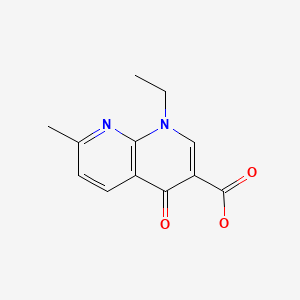Attribution Statement: LactMed is a registered trademark of the U.S. Department of Health and Human Services.
NCBI Bookshelf. A service of the National Library of Medicine, National Institutes of Health.
Drugs and Lactation Database (LactMed®) [Internet]. Bethesda (MD): National Institute of Child Health and Human Development; 2006-.
CASRN: 389-08-2

Drug Levels and Effects
Summary of Use during Lactation
Limited information indicates that maternal doses of nalidixic acid up to 2 grams daily produce low levels in milk and would usually not be expected to cause any adverse effects in breastfed infants with monitoring of the infant for possible effects on the gastrointestinal flora, such as diarrhea or candidiasis (thrush, diaper rash). Nalidixic acid should be avoided while breastfeeding a glucose-6-phosphate dehydrogenase (G6PD) deficient infant. Other agents are preferred, especially while nursing a newborn or preterm infant.
Drug Levels
Maternal Levels. One paper reported old, unpublished data obtained from the manufacturer in which a breastmilk concentration of 2 mg/L was found at an unspecified time in 4 women taking nalidixic acid 1 gram orally 4 times daily.[1]
Thirteen lactating women were given 2 grams of nalidixic acid as a single dose between the third and eighth day postpartum. The average concentration of nalidixic acid in milk during the first four-hour collection period was 0.64 mg/L (range 0.3 to 1.1 mg/L); concentration in milk from other collection periods were as follows: 0.43 mg/L at 4 to 7 hours; 0.2 mg/L at 7 to 10.5 hours; 0.1 mg/L at 10.5 to 16 hours and 0.02 mg/L at 16 to 24 hours after the dose. Using the peak milk level data from this study, the authors estimated that an exclusively breastfed infant would receive a maximum of 300 mcg daily with this maternal dosage regimen, or less than 0.3% of an infant dose.[2]
Infant Levels. Relevant published information was not found as of the revision date.
Effects in Breastfed Infants
Decreased weight gain, pallor, jaundice occurred in a 16-day-old infant probably caused by hemolytic anemia induced by maternal use of nalidixic acid orally 1 gram four times daily and amobarbital 65 mg orally three times daily. The infant developed jaundice, hyperbilirubinemia, reticulocytosis, eosinophilia, Heinz bodies and other signs of hemolysis 7 days after its mother was started on nalidixic acid. No G-6-PD deficiency or hemoglobin Zurich could be demonstrated.[1]
Effects on Lactation and Breastmilk
Relevant published information was not found as of the revision date.
Alternate Drugs to Consider
References
- 1.
- Belton EM, Jones RV. Haemolytic anaemia due to nalidixic acid. Lancet 1965;286:691. Letter. PMID: 4158226. [PubMed: 4158226]
- 2.
- Traeger A, Peiker G. Excretion of nalidixic acid via mother's milk. Arch Toxicol Suppl. 1980;4:388–90. [PubMed: 6933944]
Substance Identification
Substance Name
Nalidixic Acid
CAS Registry Number
389-08-2
Disclaimer: Information presented in this database is not meant as a substitute for professional judgment. You should consult your healthcare provider for breastfeeding advice related to your particular situation. The U.S. government does not warrant or assume any liability or responsibility for the accuracy or completeness of the information on this Site.
- User and Medical Advice Disclaimer
- Drugs and Lactation Database (LactMed) - Record Format
- LactMed - Database Creation and Peer Review Process
- Fact Sheet. Drugs and Lactation Database (LactMed)
- Drugs and Lactation Database (LactMed) - Glossary
- LactMed Selected References
- Drugs and Lactation Database (LactMed) - About Dietary Supplements
- Breastfeeding Links
- PubChem SubstanceRelated PubChem Substances
- PubMedLinks to PubMed
- Review Mycophenolate.[Drugs and Lactation Database (...]Review Mycophenolate.. Drugs and Lactation Database (LactMed®). 2006
- Review Norfloxacin.[Drugs and Lactation Database (...]Review Norfloxacin.. Drugs and Lactation Database (LactMed®). 2006
- Review Enoxacin.[Drugs and Lactation Database (...]Review Enoxacin.. Drugs and Lactation Database (LactMed®). 2006
- Review Meclofenamate.[Drugs and Lactation Database (...]Review Meclofenamate.. Drugs and Lactation Database (LactMed®). 2006
- Review Mefenamic Acid.[Drugs and Lactation Database (...]Review Mefenamic Acid.. Drugs and Lactation Database (LactMed®). 2006
- Nalidixic Acid - Drugs and Lactation Database (LactMed®)Nalidixic Acid - Drugs and Lactation Database (LactMed®)
Your browsing activity is empty.
Activity recording is turned off.
See more...
